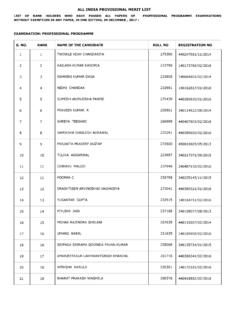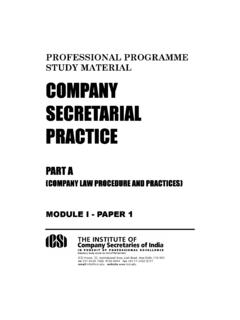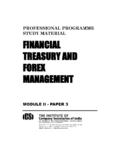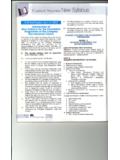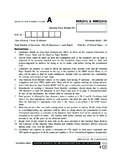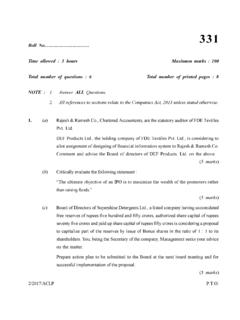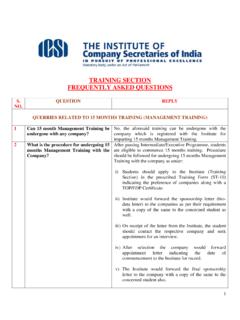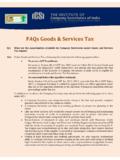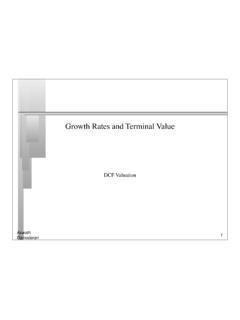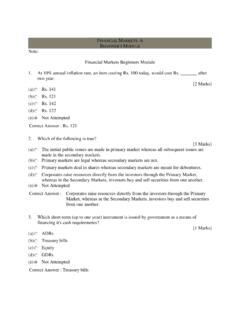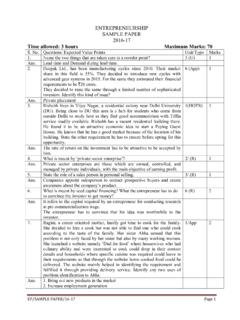Transcription of GUIDELINE ANSWERS - ICSI
1 GUIDELINE ANSWERSPROFESSIONAL PROGRAMME(New Syllabus)DECEMBER 2020 MODULE 3 ICSI House, 22, Institutional Area, Lodi Road, New Delhi 110 003 Phones : 41504444, 45341000; Fax : 011-24626727E-mail : Website : O N T E N T S PageMODULE Funding & Listing in Stock Case - Law & Practice (Elective Paper ) - Law & Practice (Elective Paper ) Property Rights - Laws and Practices(Elective Paper ) Audit (Elective Paper ) Tax Law & Practice (Elective Paper ) Laws & Practice (Elective Paper ) & Business Modelling (Elective Paper ) - Law and Practice (Elective Paper )155 These ANSWERS have been written by competent persons and the Institutehope that the GUIDELINE ANSWERS will assist the students in preparingfor the Institute's examinations. It is, however, to be noted that the answersare to be treated as model ANSWERS and not as exhaustive and the Instituteis not in any way responsible for the correctness or otherwise of theanswers compiled and published ANSWERS to the questions based on case study, the students maywrite any other alternative answer with valid GUIDELINE ANSWERS contain information based on the Laws/Rulesrelevant for the Session.
2 Students are expected to be well versed withthe amendments in the Laws/Rules made upto six months prior to thedate of CFLSE December 2020 PROFESSIONAL PROGRAMME EXAMINATIONDECEMBER 2020 CORPORATE FUNDING & LISTING IN STOCK EXCHANGESTime allowed : 3 hours Maximum marks : 100 NOTE : Answer ALL AQuestion 1(a)Define and discuss the conditions for Preferential Issue. When an issuerbecomes ineligible to make a such issue ? (5 marks)(b)State the guidelines issued by RBI (Reserve Bank of India) for large borrowersunder the cash credit facility. (5 marks)(c)Balance Sheet of X company as at 31st March, 2018 and its statement ofchanges in financial position for the year ending on 31st March, 2019 arepresented below:Balance Sheet as at 31st March, 2018 Liability `Assets `Common Stock6,000 Land9,800 Reserves6,560 Equipment12,200 Preferential Stock2,500 Accumulated Depreciation(2,000)Long term Bonds7,000 Inventory2,370 Amount Payable2,140 Amount Receivable1,300 Cash53024,20024,200 Statement of changes in Financial Position for the year ended on 31st March,2019 :Sources`Uses`Net Income1,200 Paid Cash Dividend360 Depreciation600 Repaid Preferential Stock2,500 Loss on sale of land(80)Retired Bond Payable1,400 Issued Stock4,000 Purchased Equipment3,000 Sold land1,880 Increase in Working Capital3407,6007,600 Calculate the working capital as on 31st March, 2019.
3 (5 marks)PP CFLSE December 20202 Answer 1(a)Define and discuss the conditions for preferential issue:A listed issuer may make a preferential issue of specified securities, if: all equity shares allotted by way of preferential issue shall be made fully paid upat the time of the allotment; a special resolution has been passed by its shareholders; all the equity shares, if any, held by the proposed allottees in the issuer are indematerialised form; the issuer is in compliance with the conditions for continuous listing of equityshares as specified in the listing agreement with the recognised stock exchangewhere the equity shares of the issuer are listed, SEBI Listing Regulations, 2015as amended, and any circular or notifications issued by SEBI thereunder; the issuer has obtained the Permanent Account Number of the proposed an issuer becomes ineligible to make a such issue of specified securities shall not be made to any person whohas sold or transferred any equity shares of the issuer during the six monthspreceding the relevant issuer shall not be eligible to make a preferential issue if any of its promotersor directors is a fugitive economic any person belonging to promoter(s) or the promoter group has previouslysubscribed to warrants of an issuer but failed to exercise the warrants, thepromoter(s) and promoter group shall be ineligible for issue of specified securitiesof such issuer on preferential basis for a period of one year from :(a)the date of expiry of the tenure of the warrants due to non-exercise of theoption to convert; or(b)the date of cancellation of the warrants, as the case may 1(b)In respect of borrowers having aggregate fund based working capital limit of Rs.
4 1500million and above from the banking system, a minimum level of loan component of 40percent shall be effective from April 1, 2019. Accordingly, for such borrowers, the outstanding loan component (Working Capital Loan) must be equal to at least 40 percent of thesanctioned fund based working capital limit, including ad hoc limits and TODs. Hence,for such borrowers, drawings up to 40 percent of the total fund based working capitallimits shall only be allowed from the loan component . Drawings in excess of the minimum loan component threshold may be allowed in the form of cash credit facility. The bifurcationof the working capital limit into loan and cash credit components shall be effected afterexcluding the import credit limits and bills limit for inland sales from the working capitallimit. {Ok in terms of page of module}3PP CFLSE December 2020 Answer 1(c)Working capital as on 31st March, 2018 Opening w. c.(Rs.) = Cash + AR + Inv. - AP=530+1300+ 2370 -2140=2060 Hence as on 31st March 2019=Opening + change in for the year ended on march 31, 2019=Rs.
5 2060 + 2400 Attempt all parts of either Q. No. 2 or Q. No. 2 AQuestion 2(a)Explain guidelines issued by SEBI on participation by the strategic investors inInvITs and REITs vide its circular dated 18th January, 2018.(b)Explain the provisions relating to maintenance of records by an investmentmanager pertaining to the activity of the InvIT.(c)Define briefly the following in context of Indian equity private funding :(1)Alternative Investment Fund(2)Infrastructure Fund(3)Social Venture Fund(4)Sponsor(5)Venture Capital Fund. (5 marks each)OR (Alternate question to Q. No. 2)Question 2A(i)Explain the conditions to become an Angel investor under SEBI (Venture CapitalFund) Regulations, 1996.(ii)On 30th May, 2017 SEBI came out with a circular stating the disclosurerequirements for issuance and listing of Green Debt Securities in India. Explainthe Disclosure Document and other requirements in this context.(iii)Differentiate between Hire Purchase and Hypothecation.
6 (5 marks each)Answer 2(a)Participation by the strategic investors in the public issue of the REITs(i)Holding requirements-Holding by strategic investors Minimum 5%, maximum 25%.-Holding by public, other than strategic investors and sponsor Minimum25%-Holding by sponsor Minimum 5%, maximum 70%PP CFLSE December 20204(ii)Issue price of the units and utilisation of funds-The price at which units are offered to the strategic investors must not beless than the price determined in the public must be ensured that the subscription amount is kept in the separateaccount until the public issue is opened.(iii)Lock-in period-The units subscribed by strategic investors, pursuant to the unit subscriptionagreement, will be locked-in for a period of 180 days from the date of listingin the public 2(b)The investment manager shall maintain records pertaining to the activity of the InvIT,wherever applicable, including, (a)all investments or divestments of the InvIT and documents supporting the sameincluding rationale for such investments or divestments;(b)agreements entered into by the InvIT or on behalf of the InvIT;(c)documents relating to appointment of persons;(d)insurance policies for infrastructure assets;(e)investment management agreement;(f)documents pertaining to issue and listing of units including placementmemorandum, draft and final offer document, in- principle approval by designatedstock exchanges, listing agreement with the designated stock exchanges, detailsof subscriptions, allotment of units, etc;(g)distributions declared and made to the unit holders.
7 (h)disclosures and periodical reporting made to the trustee, SEBI, unit holders andthe designated stock exchanges including annual reports, half yearly reports,etc.;(i)valuation reports including methodology of valuation;(j)books of accounts and financial statements;(k)audit reports;(l)reports relating to activities of the InvIT placed before the board of directors of theinvestment manager;(m)unit holders grievances and actions taken thereon including copies ofcorrespondences made with the unit holder and SEBI, if any;(n)any other material 2(c) investment fund : means any fund established or incorporated inIndia in the form of a trust or a company or a limited liability partnership or abody corporate which:(i)is a privately pooled investment vehicle which collects funds from investors,whether Indian or foreign, for investing it in accordance with a definedinvestment policy for the benefit of its investors; and5PP CFLSE December 2020(ii) is not covered under the SEBI (mutual funds) regulations, 1996, SEBI(Collective Investment Schemes) regulations, 1999 or any other regulationsof the SEBI to regulate fund management activities.
8 [ok] Fund : means an Alternative Investment Fund which invests primarilyin enlisted securities or partnership interest or listed debt or securitized debtinstruments of investee companies or special purpose vehicles engaged in orformed for the purpose of operating, developing, or holding infrastructure shall be as defined by GOI from time to Venture Fund : means an alternative investment fund which invests primarilyin securities or units of social ventures and which satisfies social performancenorms laid down by the fund and whose investors may agree to receive restrictedor muted : means any person or persons who set up the Alternative InvestmentFund and includes promoter in case of a company and designated partner incase of a limited liability partnership5. Venture Capital Fund : means an Alternative Investment Fund which investsprimarily in unlisted securities of start-ups, emerging or early-stage venture capitalundertakings mainly involved in new products, new services, technology orintellectual property right based activities or a new business model and shallinclude an angel fund as defined under Chapter III-A of the SEBI (AIF)Regulations, 2A(i) Angel Investor means any person who proposes to invest in an angel fund andsatisfies one of the following conditions, namely,(a)an individual investor who has net tangible assets of at least two crore rupeesexcluding value of his principal residence, and who: has early stage investment experience, or has experience as a serial entrepreneur, or is a senior management professional with at least ten years of experience.
9 (b)a body corporate with a net worth of at least ten crore rupees; or(c)an Alternative Investment Fund registered under SEBI AIF Regulations or a VentureCapital Fund registered under the SEBI (Venture Capital Funds) Regulations, 2A(ii)The issuer of a Green Debt Securities shall make following disclosures:(i)A statement on environmental objectives of the issue of Green Debt Securities;(ii)Brief details of decision-making process issuer have followed/would follow fordetermining the eligibility of project(s) and/or asset(s), for which the proceedsPP CFLSE December 20206are been raised through issuance of Green Debt Securities. An indicative guidelineof the details to be provided is as under: process followed/to be followed for determining how the project(s) and/orasset(s) fit within the eligible green projects categories; the criteria, making the project(s) and/or asset(s) eligible for using the GreenDebt Securities proceeds; and environmental sustainability objectives of the proposed green investment.
10 (iii)Issuer shall provide the details of the system/procedures to be employed fortracking the deployment of the proceeds of the issue.(iv)Details of the project(s) and/or asset(s) or areas where the issuer, proposes toutilise the proceeds of the issue of Green Debt Securities, including towardsrefinancing of existing green project(s) and/or asset(s), if any.(v)The issuer may appoint an independent third party reviewer/certifier, for reviewing/certifying the processes including project evaluation and selection criteria, projectcategories eligible for financing by Green Debt Securities, etc. Such appointmentis optional and shall be disclosed in the offer 2A(iii)Hire PurchaseHP transactions are very similar to leasing transactions. Like Leasing Finance, inHire Purchase, the ownership of the vehicle continues to remain with the Leasing Companytill the agreement period ends. However, at the end of the stipulated period, the hirer(lessee) has options either to return the asset to leasing company while terminating theagreement or purchase the asset upon terms set out in the hire-purchase agreement.
